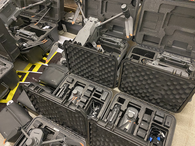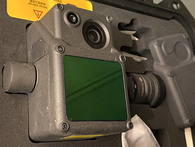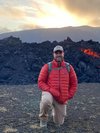Drones in Volcanology: Enhancing Research and Safety




Drones have emerged as invaluable tools in the field of volcanology, offering numerous advantages that significantly enhance research capabilities and improve safety. Here’s why our drones are so important for us:
Access to Hazardous Areas: Our drones can safely access and survey active volcanic sites that are too dangerous or inaccessible for researchers. This allows for close-up observations and data collection from the crater and other hazardous zones.
Real-Time Monitoring: Equipped with cameras, thermal sensors, and gas analyzers, drones provide real-time data on volcanic activity. This includes monitoring gas emissions, thermal anomalies, and changes in the landscape, which are crucial for predicting eruptions and understanding volcanic behavior.
High-Resolution Mapping: Our drones can capture high-resolution aerial imagery and create detailed topographic maps of volcanic terrain. These maps are essential for studying the geomorphology of volcanoes, analyzing lava flow paths, and assessing the impact of eruptions on the environment.
Cost-Effectiveness: Compared to traditional manned aircraft or satellite imagery, our drones are relatively inexpensive. They offer a cost-effective means of conducting repeated surveys and long-term monitoring, making it feasible to study remote or less accessible volcanoes.
Rapid Deployment: Our drones can be quickly deployed in response to volcanic events. This rapid deployment capability is crucial for emergency response and disaster management, providing immediate insights that can inform evacuation plans and hazard mitigation strategies.
Enhanced Data Collection: Drones are equipped with advanced sensors such as Lidar and thermal infrared that can collect a wide range of data. Also multi-spectral and hyper-spectral data collection enhances the understanding of volcanic processes, aiding in the development of more accurate models and predictions.
Minimizing Environmental Impact: Drones have a minimal environmental footprint compared to other methods of data collection, such as ground surveys or manned flights. This non-invasive approach is particularly beneficial in preserving the delicate ecosystems around volcanoes.
Interdisciplinary Applications: The data collected by drones can be used in various interdisciplinary studies, including geology, atmospheric science, and environmental science. Currently we develop drones to deploy seismic stations.
Publications
Walter, Thomas (2024): Drone based photogrammetry data at the Geysir geothermal field, Iceland. GFZ Data Services. https://doi.org/10.5880/GFZ.2.1.2024.001
Lun, A., Walter, T., Aguilera, F., Layana, S., Mania, R., Kujawa, C., Zimmer, M., Inostroza, M. (2023): Crater morphology, nested ring structures, and temperature anomalies studied by unoccupied aircraft system data at Lascar volcano, northern Chile. - Journal of Volcanology and Geothermal Research, 439, 107840. https://doi.org/10.1016/j.jvolgeores.2023.107840.
Marzban, P., S. Bredemeyer, T.R. Walter, F. Kaestner, D. Mueller, and S. Chabrillat, 2023, Hydrothermally altered deposits of 2014 Askja landslide, Iceland, identified by remote sensing imaging. Frontiers in Earth Science. 11. https://doi.org/10.3389/feart.2023.1083043.
Allahbakhshi, M.; Shevchenko, A.V.; Belousov, A.B.; Belousova, M.G.; Kämpf, H.; Walter, T.R. Geothermal Explosion at the 2014 Landslide-Covered Area of the Geyser Valley, Kamchatka, Russian Far East. GeoHazards 2023, 4, 60-76. https://doi.org/10.3390/geohazards4010005.
Darmawan, H., Putra, R., Budi-Santoso, A., Humaida, H., Walter, T. (2023): Morphology and Instability of the Merapi Lava Dome Monitored by Unoccupied Aircraft Systems. - In: Gertisser, R., Troll, V. R., Walter, T., Nandaka, I. G. M. A., Ratdomopurbo, A. (Eds.), Merapi Volcano: Geology, Eruptive Activity, and Monitoring of a High-Risk Volcano, (Active Volcanoes of the World), Cham: Springer International Publishing, 457-472. https://doi.org/10.1007/978-3-031-15040-1_15.
Mueller, D., T.R. Walter, M. Zimmer, and G. Gonzalez, 2022, Distribution, structural and hydrological control of the hot springs and geysers of El Tatio, Chile, revealed by optical and thermal infrared drone surveying. Journal of Volcanology and Geothermal Research. 432. https://doi.org/10.1016/j.jvolgeores.2022.107696.
Darmawan, H., V.R. Troll, T.R. Walter, F.M. Deegan, H. Geiger, M.J. Heap, N. Seraphine, C. Harris, H. Humaida, and D. Muller, 2022, Hidden mechanical weaknesses within lava domes provided by buried high-porosity hydrothermal alteration zones. Nature Scientific Reports. 12(1). https://doi.org/10.1038/s41598-022-06765-9.
Bindeman, I.N., F.M. Deegan, V.R. Troll, T. Thordarson, A. Hoskuldsson, W.M. Moreland, E.U. Zorn, A.V. Shevchenko, and T.R. Walter, 2022, Diverse mantle components with invariant oxygen isotopes in the 2021 Fagradalsfjall eruption, Iceland. Nature Communications. 13(1). https://doi.org/10.1038/s41467-022-31348-7.
Shevchenko, A.V., V.N. Dvigalo, E.U. Zorn, M.S. Vassileva, F. Massimetti, T.R. Walter, I.Y. Svirid, S.A. Chirkov, A.Y. Ozerov, V.A. Tsvetkov, and I.A. Borisov, 2021, Constructive and Destructive Processes During the 2018-2019 Eruption Episode at Shiveluch Volcano, Kamchatka, Studied From Satellite and Aerial Data. Frontiers in Earth Science. 9. https://doi.org/10.3389/feart.2021.680051.
Mueller, D., S. Bredemeyer, E. Zorn, E. De Paolo, and T.R. Walter, 2021, Surveying fumarole sites and hydrothermal alteration by unoccupied aircraft systems (UAS) at the La Fossa cone, Vulcano Island (Italy). Journal of Volcanology and Geothermal Research. 413. https://doi.org/10.1016/j.jvolgeores.2021.107208.
Zorn, E.U., T.R. Walter, J.B. Johnson, and R. Mania, 2020, UAS-based tracking of the Santiaguito Lava Dome, Guatemala. Scientific Reports. 10(1). https://doi.org/10.1038/s41598-020-65386-2.
Walter, T.R., P. Jousset, M. Allahbakhshi, T. Witt, M.T. Gudmundsson, and G.P. Hersir, 2020, Underwater and drone based photogrammetry reveals structural control at Geysir geothermal field in Iceland. Journal of Volcanology and Geothermal Research. 391. https://doi.org/10.1016/j.jvolgeores.2018.01.010.
Walter, T.R., A. Belousov, M. Belousova, T. Kotenko, and A. Auer, 2020, The 2019 Eruption Dynamics and Morphology at Ebeko Volcano Monitored by Unoccupied Aircraft Systems (UAS) and Field Stations. Remote Sensing. 12(12). https://doi.org/10.3390/rs12121961.
James, M., Carr, B., D'Arcy, F., Diefenbach, A., Dietterich, H., Fornaciai, A., Lev, E., Liu, E., Pieri, D., Rodgers, M., Smets, B., Terada, A., von Aulock, F., Walter, T., Wood, K., Zorn, E. (2020): Volcanological applications of unoccupied aircraft systems (UAS): Developments, strategies, and future challenges. - Volcanica, 3, 1, 67-114. https://doi.org/10.30909/vol.03.01.67114.
Gaete, A., T.R. Walter, S. Bredemeyer, M. Zimmer, C. Kujawa, L.F. Marin, J. San Martin, and C.B. Parra, 2020, Processes culminating in the 2015 phreatic explosion at Lascar volcano, Chile, evidenced by multiparametric data. Natural Hazards and Earth System Sciences. 20(2): p. 377-397. https://doi.org/10.5194/nhess-20-377-2020.
Walter, T.R., J. Salzer, N. Varley, C. Navarro, R. Arambula-Mendoza, and D. Vargas-Bracamontes, 2018, Localized and distributed erosion triggered by the 2015 Hurricane Patricia investigated by repeated drone surveys and time lapse cameras at Volcan de Colima, Mexico. Geomorphology. 319: p. 186-198. https://doi.org/10.1016/j.geomorph.2018.07.020.
Darmawan, H., T.R. Walter, K.S. Brotopuspito, Subandriyo, and I.G.M.A. Nandaka, 2018, Morphological and structural changes at the Merapi lava dome monitored in 2012-15 using unmanned aerial vehicles (UAVs). Journal of Volcanology and Geothermal Research. 349: p. 256-267. https://doi.org/10.1016/j.jvolgeores.2017.11.006.
Muller, D., T.R. Walter, A. Schopa, T. Witt, B. Steinke, M.T. Gudmundsson, and T. Durig, 2017, High-Resolution Digital Elevation Modeling from TLS and UAV Campaign Reveals Structural Complexity at the 2014/2015 Holuhraun Eruption Site, Iceland. Frontiers in Earth Science. 5. https://doi.org/10.3389/feart.2017.00059.
(for publications older than this please refer to the GFZ section 2.1 publication page)



